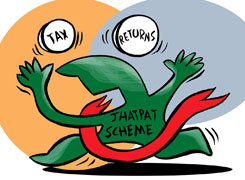Anil Rego | Answer |Ask -Follow
Financial Planner - Answered on Aug 29, 2022
He’s an expert in income tax and wealth management.
He has completed his CFA/MBA from the ICFAI Business School.... more

I have paid Single Premium of Rs 100,000 for my son's LIC policy in the year 2012. In the year March 2022, the policy matured for Rs 200,814 and bonus of Rs 12,354. The entire amount was re-invested with additional premium amount of Rs 76,375 as single premium under plan of 917 for 25 years of LIC.
Will the difference amount of Rs 100,814 with bonus amount of Rs 12,354 attract tax? If so, under normal tax rate or LTCG?
Will the entire amount of Rs 289,543 entitled U/s 80C or only differential premium amount of Rs 76,375 be considered U/s 80C?
Shall be thankful for your views.
For life insurance plans issued after April 1, 2012, the exemption from tax on single premium life insurance is valid only when the premium is less than 10% of the total sum assured.
Now, if the policy is taken before April 2012, you could avail the exemptions under Section 10D if the premiums paid in a single year during the policy term are not more than 20% of the sum assured. You will need to show the entire maturity proceeds in your return if taxable.
The entire premium of a life insurance plan is eligible for a tax deduction as per Section 80C up to a maximum limit of Rs 1.5 lakh.
You may like to see similar questions and answers below
Ramalingam Kalirajan |10881 Answers |Ask -Follow
Mutual Funds, Financial Planning Expert - Answered on May 09, 2024
Ramalingam Kalirajan |10881 Answers |Ask -Follow
Mutual Funds, Financial Planning Expert - Answered on Aug 02, 2024
T S Khurana |536 Answers |Ask -Follow
Tax Expert - Answered on Sep 17, 2024
Ramalingam Kalirajan |10881 Answers |Ask -Follow
Mutual Funds, Financial Planning Expert - Answered on Jul 03, 2025
Dr Dipankar Dutta |1839 Answers |Ask -Follow
Tech Careers and Skill Development Expert - Answered on Dec 13, 2025
Dr Dipankar Dutta |1839 Answers |Ask -Follow
Tech Careers and Skill Development Expert - Answered on Dec 13, 2025
Mayank Chandel |2575 Answers |Ask -Follow
IIT-JEE, NEET-UG, SAT, CLAT, CA, CS Exam Expert - Answered on Dec 13, 2025
Radheshyam Zanwar |6742 Answers |Ask -Follow
MHT-CET, IIT-JEE, NEET-UG Expert - Answered on Dec 13, 2025
Mayank Chandel |2575 Answers |Ask -Follow
IIT-JEE, NEET-UG, SAT, CLAT, CA, CS Exam Expert - Answered on Dec 13, 2025
Mayank Chandel |2575 Answers |Ask -Follow
IIT-JEE, NEET-UG, SAT, CLAT, CA, CS Exam Expert - Answered on Dec 13, 2025
Kanchan Rai |646 Answers |Ask -Follow
Relationships Expert, Mind Coach - Answered on Dec 12, 2025
Ravi Mittal |677 Answers |Ask -Follow
Dating, Relationships Expert - Answered on Dec 12, 2025
Ramalingam Kalirajan |10881 Answers |Ask -Follow
Mutual Funds, Financial Planning Expert - Answered on Dec 12, 2025
Ramalingam Kalirajan |10881 Answers |Ask -Follow
Mutual Funds, Financial Planning Expert - Answered on Dec 12, 2025



























